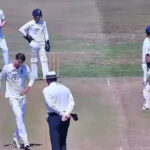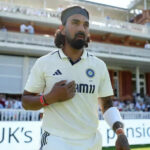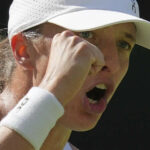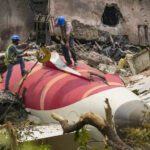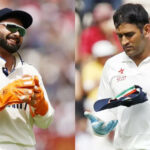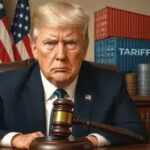This article is an onsite version of our Europe Express newsletter. Sign up here to get the newsletter sent straight to your inbox every weekday and Saturday morning. Explore all of our newsletters here
Welcome back. In a message on Monday for the world’s grandparents and elderly people, Pope Francis said:
God never abandons his children, never. Even when our age advances and our powers decline, when our hair grows white and our role in society lessens, when our lives become less productive and can risk appearing useless.
From the 87-year-old pope, now more than 11 years into his tumultuous reign, it was a poignant reflection on the slackened faculties of old age. Inevitably, attention is turning to the question of who might succeed him at the Holy See — and whether the next pope would do any better than Francis at calming the seething tensions in the Vatican and the worldwide Catholic Church over doctrine, policies and personnel. I’m at tony.barber@ft.com.
First, some housekeeping. The weekend edition of Europe Express will take a pause next week. Normal service will resume on Saturday August 17.
A small, powerful electorate
Although he’s not in the pink of health, Francis wrote earlier this year in his memoir Life: My story through history that he had never thought about following the example of Benedict, his predecessor, and abdicating. At the same time, he mentioned that, at the start of his reign, he had signed a statement to the effect that he would resign if bad health made it impossible for him to perform his duties.
One way or another, Vatican-watchers know it is only a matter of time before a conclave of cardinals meets in the Sistine Chapel to select the next pope. For its size, it truly is the world’s most powerful electorate — there are 236 cardinals at the moment, but only 125 are under the age of 80 and therefore eligible to vote for the man who will lead the Church and its faithful around the world (estimated in the Vatican’s latest Pontifical Yearbook at almost 1.4bn people in 2022).
The Vatican’s website is full of interesting details on the college of cardinals. The chart below, which breaks it down by geographical region, shows that Europe will provide 51 voting cardinals (about 40 per cent of the total), Asia 21, central and South America 18, Africa 17 and North America 15.

It would, of course, be misleading to suggest that the cardinals will vote in continental blocs. Nevertheless, these figures reflect the gradual decline of organised Catholicism in the Church’s historical European heartland and the rise in influence of some African, Asian and Latin American countries where the religion is thriving.

Predicting conclaves: a mug’s game
Francis, who is from Argentina, is the first non-European pope since the Syrian-born Gregory III, who reigned in the eighth century. He has done a great deal to shape the choice of the next conclave by appointing no fewer than 92 of the 125 cardinals who will have a vote.
However, this by no means makes it certain that the next pope will be non-European or even of a similar theological outlook to Francis. As John Thavis wrote in November in a well-judged article explaining how the electoral process works:
“The dynamics of papal conclaves are notoriously difficult to predict.”
Conclaves are usually shrouded in secrecy: cardinals take an oath not to disclose the manoeuvres and calculations behind their choice. However, in another publication this year, The Successor: My memories of Benedict XVI, Francis took the extraordinary step of revealing some of what went on behind closed doors at the conclaves of 2005 and 2013. “Popes have licence to talk,” he observed.
The 2005 conclave
In 2005, after the death of the Polish-born John Paul II, the decision eventually went in favour of Cardinal Joseph Ratzinger of Germany (the future Benedict) — but not before some shenanigans that wouldn’t have looked out of place at a US political party convention in the 1920s.
According to Francis — then Cardinal Jorge Mario Bergoglio — he won the support of 40 out of 115 cardinals in the conclave’s third vote, not because he was seeking the papacy but because a group of cardinals wanted to block Ratzinger.

The idea was to destroy Ratzinger’s chances and then switch the pro-Bergoglio vote to a third candidate who wouldn’t be “foreign” — that’s to say, non-Italian. Francis put an end to all this by telling other cardinals that he wouldn’t play along with the anti-Ratzinger camp. The German was duly chosen in the fourth ballot.
Identifying the papabili
So who are the frontrunners, or the papabili as they are known in Italian?
Writing in the Catholic Herald, the experienced commentator John L Allen Jr says we should keep an eye on Cardinal Fridolin Ambongo Besungu, 64, the archbishop of Kinshasa.
Ambongo led the resistance of Africa’s bishops to Fiducia Supplicans, a Vatican document that made it permissible for priests to bless people in same-sex relationships.
Although this puts him at odds with liberal-minded European cardinals, Ambongo is no rebel prelate or even a malcontent like, say, George Pell, the late Australian cardinal. Pell was revealed after his death last year to have been the author of a memo, published under a pseudonym, that called Francis’s leadership a “catastrophe”.
According to Allen, another papabile is Cardinal Pietro Parolin, 69, the Vatican’s secretary of state, or highest-ranking diplomat. He is Italian, which might not work to his advantage (there hasn’t been an Italian pope since 1978), but Allen says:
The argument for Parolin all along has been that he would deliver the substance of Francis’s papacy but not its mercurial, shoot-from-the-hip style.
Finally, Allen says one papabile whose stock is falling is Cardinal Victor Manuel Fernández of Argentina, who enforces theological orthodoxy as the head of the Dicastery for the Doctrine of the Faith.
Fernández ran into difficulties when it emerged that, as a young priest, he’d written a book that featured an imaginary erotic encounter with Jesus on the shores of Galilee. For good measure, he explored the nature of orgasms in startling detail.
Progressives and conservatives
Whoever succeeds Francis will have a Herculean task on his hands. In many ways, the hardest problem of all to solve — indeed, it probably doesn’t have a solution — is that, since John Paul II’s reign, the conflicts between progressives and conservatives in the Catholic Church have come to reflect, and to be infected by, similar controversies in secular politics in the US, European democracies and the non-western world.
Francis has navigated these storms with mixed success.
In Let Us Dream: The Path to a Better Future, a book he published in 2020, Francis denounced “various kinds of populism” — implicitly, of the rightwing type — “that deform the meaning of the word ‘people’ by hitching it to ideologies that focus on perceived enemies, internal and external”.
However, he was equally critical of left-leaning liberalism, calling it a world view that “exalts and promotes the atomised individual, leaving little room for fraternity and solidarity”.
In short, Francis is neither as liberal as his conservative opponents contend, nor as conservative as his liberal adversaries suggest. He is treading a narrow path between two mutually hostile camps within the organised Church and among the Catholic faithful worldwide.
Francis promotes cautious change
That said, Francis has taken certain steps that make clear his impatience with the conservative forces. In January 2021, he changed Church law to allow women to administer communion and serve at the altar — though they cannot be ordained as priests.
Six months later, he enraged traditionalists by reimposing restrictions on the celebration of the Latin Mass that the more conservative Benedict had lifted in 2007.
In other ways that have attracted less attention, Francis has updated the Church’s ideas and practices. In March 2023, the Vatican repudiated the so-called “doctrine of discovery”, laid out in various 15th-century papal decrees, that had been used to justify European colonialism.
A couple of months ago, the Vatican issued new rules that strip bishops of the power to recognise the validity of “supernatural” phenomena such as apparitions of the Virgin Mary.

In conclusion, there will be everything to play for at the next conclave.
In 2005 I was living in Rome and reported on the conclave that elected Benedict. There hadn’t been a conclave for 27 years, and I vividly remember the excitement in the Italian capital, as well as the worldwide interest — including for readers of the FT! It was as great as for any important event like a US presidential election.
I’m convinced that the interest will be just as big next time.
The global pontificate of Pius XII: Catholicism in a divided world, 1945-1958 — the website of a group of international historians studying newly available sources in the Vatican archives
Tony’s picks of the week
-
Donald Trump’s election-time enthusiasm for bitcoin marks an about-turn for a man who three years ago derided it as a “scam” that threatened the US dollar, the FT’s Alex Rogers, Nikou Asgari and George Hammond report
-
Maia Sandu, Moldova’s western-leaning president, will face a formidable opponent in the country’s presidential elections on October 20: former prosecutor-general Alexandr Stoianoglo, Vladimir Solovyov writes for Carnegie Politika
Recommended newsletters for you
Are you enjoying Europe Express? Sign up here to have it delivered straight to your inbox every workday at 7am CET and on Saturdays at noon CET. Do tell us what you think, we love to hear from you: europe.express@ft.com. Keep up with the latest European stories @FT Europe
